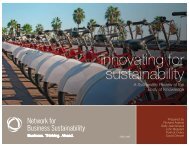embedding sustainability in organizational culture - Network for ...
embedding sustainability in organizational culture - Network for ...
embedding sustainability in organizational culture - Network for ...
You also want an ePaper? Increase the reach of your titles
YUMPU automatically turns print PDFs into web optimized ePapers that Google loves.
Chapter 1: 3: Introduction Foster<strong>in</strong>g Commitment<br />
24<br />
accoMModatE woRk–lifE BalancE: Make an ef<strong>for</strong>t to address family-life<br />
commitments and social benefits <strong>for</strong> employees, and to see employees as<br />
a whole person and part of the community<br />
• Provide social benefits <strong>for</strong> employees<br />
• Support job flexibility<br />
• Support the personal growth of employees<br />
Another way to signal the importance of <strong>susta<strong>in</strong>ability</strong> <strong>for</strong> the organization is to<br />
implement programs that attempt to balance the demands of work<strong>in</strong>g life and home<br />
life <strong>for</strong> employees. Ef<strong>for</strong>ts to make work<strong>in</strong>g life and family life more compatible<br />
<strong>in</strong>clude flexible work schedules, part-time work, and social benefits <strong>for</strong> employees.<br />
These practices signal an understand<strong>in</strong>g of the social dimension of <strong>susta<strong>in</strong>ability</strong>. By<br />
support<strong>in</strong>g these types of practices, an organization creates alignment between what<br />
they say and how they operate.<br />
While these practices were proposed both by practitioners and researchers, we<br />
found no research that explored the impact of accommodat<strong>in</strong>g work–life balance on<br />
<strong>embedd<strong>in</strong>g</strong> <strong>susta<strong>in</strong>ability</strong>.<br />
assessment: proposed but not tested<br />
<strong>in</strong>vESt <strong>in</strong> thE coMMunity: contribute to the community and encourage and<br />
enable employees to do the same<br />
• Contribute to community causes<br />
• Permit employees to take paid or unpaid time off to volunteer<br />
• Match contributions made by employees<br />
• Select a corporate cause and <strong>in</strong>volve all levels of the organization <strong>in</strong><br />
support<strong>in</strong>g it<br />
Practitioners have proposed that <strong>in</strong>vest<strong>in</strong>g <strong>in</strong> community causes and allow<strong>in</strong>g<br />
employees to take paid or unpaid time off to focus on volunteer<strong>in</strong>g opportunities<br />
builds commitment to <strong>susta<strong>in</strong>ability</strong> (Dunphy et al., 2003; Epste<strong>in</strong>, 2008;<br />
Ethical Corporation, 2009; Laszlo, 2003; NBS, 2010). Despite this, we found no<br />
empirical studies that exam<strong>in</strong>ed the effect of <strong>in</strong>vestments <strong>in</strong> the community and<br />
policies regard<strong>in</strong>g employee volunteerism on build<strong>in</strong>g and support<strong>in</strong>g a <strong>culture</strong> of<br />
<strong>susta<strong>in</strong>ability</strong>.<br />
assessment: proposed but not tested<br />
communicate<br />
The <strong>in</strong><strong>for</strong>mal practices presented <strong>in</strong> this quadrant rely on the ability to communicate<br />
both the value of <strong>susta<strong>in</strong>ability</strong> and the chang<strong>in</strong>g priorities and expectations <strong>for</strong><br />
how work gets done. We identified two core practices related to communicat<strong>in</strong>g:<br />
storytell<strong>in</strong>g and customiz<strong>in</strong>g. Storytell<strong>in</strong>g makes use of relatable anecdotes and<br />
examples to convey <strong>susta<strong>in</strong>ability</strong> concepts. Customiz<strong>in</strong>g refers to attempts to tailor<br />
the organization’s message to ensure that it is authentic and relevant <strong>for</strong> different<br />
<strong>in</strong>ternal and external audiences.<br />
tEll StoRiES: convey desired <strong>susta<strong>in</strong>ability</strong> behaviours through the use of<br />
examples and stories<br />
• Discuss case studies of successful <strong>susta<strong>in</strong>ability</strong> <strong>in</strong>itiatives <strong>in</strong> your<br />
organization<br />
• Create stories about what the company could be like <strong>in</strong> the future<br />
• Create simple stories and repeat them often, us<strong>in</strong>g different means<br />
• Start every meet<strong>in</strong>g with a quick <strong>susta<strong>in</strong>ability</strong> story<br />
• Use metaphors and symbols<br />
Dunphy and colleagues (2003) propose that storytell<strong>in</strong>g can open up l<strong>in</strong>es of<br />
communication, create <strong>in</strong>tegration opportunities and develop a commitment to<br />
new values. Esquer-Peralta et al. (2008) suggest shar<strong>in</strong>g case studies of successful<br />
<strong>susta<strong>in</strong>ability</strong> <strong>in</strong>itiatives <strong>in</strong> the organization, <strong>in</strong>clud<strong>in</strong>g the lessons learned along the<br />
way. Hagen (2008) found that stories that present the company as further along the<br />
journey can <strong>in</strong>spire people to live up to the ideal. One organization emphasized the<br />
importance of f<strong>in</strong>d<strong>in</strong>g a simple story that can be repeated often and <strong>in</strong> many ways<br />
so that everyone <strong>in</strong> the organization becomes familiar with it (van Marrewijk and<br />
Becker, 2004). Another organization starts every meet<strong>in</strong>g with a quick <strong>susta<strong>in</strong>ability</strong><br />
story (Ethical Corporation, 2009). Andersson and Bateman (2000) found that<br />
the use of metaphor and symbolism can be another powerful means of convey<strong>in</strong>g<br />
<strong>susta<strong>in</strong>ability</strong> messages.<br />
Jassawalla and Sashittal (2002) expla<strong>in</strong> how storytell<strong>in</strong>g is used to create the “true<br />
believers and adherents” (p. 45) essential <strong>for</strong> <strong>embedd<strong>in</strong>g</strong> <strong>in</strong>novation. Their research<br />
reveals that stories are necessary <strong>for</strong> teach<strong>in</strong>g <strong>organizational</strong> members how to th<strong>in</strong>k<br />
about and adopt new ways of do<strong>in</strong>g th<strong>in</strong>gs.
















